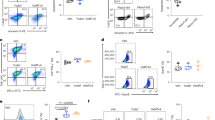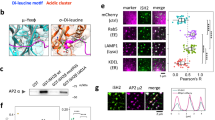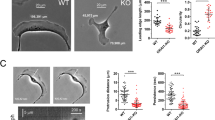Abstract
Crawling T cell locomotion in which activated lymphocyte function–associated antigen 1 (LFA-1) integrins participate is associated with translocation of the protein kinase C-β (PKC-β) isoenzyme to the microtubule cytoskeleton. In normal T cells and T lymphoma cell lines, this type of motility is accompanied by PKC-β–sensitive cytoskeletal rearrangements and the formation of trailing cell extensions, which are supported by microtubules. Expression of PKC-β(I) and enhanced green fluorescent protein (EGFP) in nonmotile PKC-β–deficient T cells restored their locomotory behavior in response to a triggering stimulus delivered via LFA-1 and correlated directly with the degree of cell polarization. We have also shown that PKC-β(I) is a component of the tubulin-enriched LFA-1–cytoskeletal complex assembled upon LFA-1 cross-linking. These observations may have physiological equivalents at advanced (post-integrin activation) stages of lymphocyte extravasation.
This is a preview of subscription content, access via your institution
Access options
Subscribe to this journal
Receive 12 print issues and online access
$209.00 per year
only $17.42 per issue
Buy this article
- Purchase on Springer Link
- Instant access to full article PDF
Prices may be subject to local taxes which are calculated during checkout








Similar content being viewed by others
References
Clark, E. A. & Brugge, J. S. Integrins and signal transduction pathways: the road taken. Science 268, 233–239 (1995).
Penninger, J. M. & Crabtree, G. R. The actin cytoskeleton and lymphocyte activation. Cell 96, 9–12 (1999).
Monks, C. R., Freiberg, B. A, Kupfer, H., Sciaky, N. & Kupfer, A. Three-dimensional segregation of supramolecular activation clusters in T cells. Nature 395, 82–86 (1998).
Dustin, M. L. & Cooper J. A. The immunological synapse and the actin cytoskeleton: molecular hardware for T cell signaling. Nature Immunol. 1, 23–29 (2000).
Springer, T. A. Traffic signals for lymphocyte recirculation and leukocyte emigration: the multistep paradigm. Cell 76, 301–314 (1994).
Siegelman, M. More than the sum of the parts: cooperation between leukocyte adhesion receptors during extravasation. J. Clin. Invest. 107, 159–160 (2001).
Zlotnik, A., Morales, J. & Hedrick, J. A. Recent advances in chemokines and chemokine receptors. Crit. Rev. Immunol. 19, 1–47 (1999).
Hauzenberger, D., Klominek, J., Bergstrom, S. E. & Sundqvist, K. G. T lymphocyte migration: the influence of interactions via adhesion molecules, the T cell receptor, and cytokines. Crit. Rev. Immunol. 15, 285–316 (1995).
Mackay, C. R. Chemokines: immunology's high impact factors. Nature Immunol. 2, 95–101 (2001).
Kelleher, D., Murphy, A., Feighery, C. & Casey, E. B. Leukocyte function-associated antigen 1 (LFA-1) and CD44 are signalling molecules for cytoskeleton-dependent morphological changes in activated T cells. J. Leukoc. Biol. 58, 539–546 (1995).
Thorp, K. M., Verschueren, H., De Baetselier, P., Southern, C. & Matthews, N. Protein kinase C isotype expression and regulation of lymphoid cell motility. Immunology 87, 434–438 (1996).
Entschladen, F., Niggemann, B., Zanker, K. S. & Friedl, P. Differential requirement of protein tyrosine kinases and protein kinase C in the regulation of T cell locomotion in three-dimensional collagen matrices. J. Immunol. 159, 3203–3210 (1997).
Volkov, Y., Long, A. & Kelleher, D. Inside the crawling T cell: LFA-1 cross-linking is associated with microtubule-directed translocation of protein kinase C isoenzymes β(I) and d. J. Immunol. 161, 6487–6495 (1998).
Kelleher, D. & Long, A. Development and characterization of a protein kinase C β-isozyme-deficient T-cell line. FEBS Lett. 301, 310–314 (1992).
Kelleher, D. & Long, A. Conventional protein kinase C isoforms are not essential for cellular proliferation of a T cell lymphoma line. FEBS Lett. 333, 243–247 (1993).
Hauzenberger, D., Klominek, J., Holgersson, J., Bergstrom, S. E. & Sundqvist, K. G. Triggering of motile behavior in T lymphocytes via cross-linking of α4β1 and αLβ2 . J. Immunol. 158, 76–84 (1997).
Rodriguez-Fernandez, J. L. et al. The interaction of activated integrin lymphocyte function-associated antigen 1 with ligand intercellular adhesion molecule 1 induces activation and redistribution of focal adhesion kinase and proline-rich tyrosine kinase 2 in T lymphocytes. Mol. Biol. Cell 10, 1891–1907 (1999).
Dustin, M.L., Bromley, S.K., Kan, Z., Peterson, D.A. & Unanue, E.R. Antigen receptor engagement delivers a stop signal to migrating T lymphocytes. Proc. Natl. Acad. Sci. USA 94, 3909–3913 (1997).
Mitchison, T. J. & Cramer, L. P. Actin-based cell motility and cell locomotion. Cell 84, 371–379 (1996).
Stewart, M. P., Cabanas, C. & Hogg, N. T cell adhesion to intercellular adhesion molecule-1 (ICAM-1) is controlled by cell spreading and the activation of integrin LFA-1. J. Immunol. 156, 1810–1817 (1996).
Nobes, C. D. & Hall, A. Rho, rac, and cdc42 GTPases regulate the assembly of multimolecular focal complexes associated with actin stress fibers, lamellipodia, and filopodia. Cell 81, 53–62 (1995).
Ratner, S., Sherrod, W. S. & Lichlyter, D. Microtubule retraction into the uropod and its role in T cell polarization and motility. J. Immunol. 159, 1063–1067 (1997).
Verschueren, H., Dewit, J., De Braekeleer, J., Schirrmacher, V. & De Baetselier, P. Motility and invasive potency of murine T-lymphoma cells: effect of microtubule inhibitors. Cell Biol. Int. 18, 11–19 (1994).
Drewes, G., Ebneth, A., Preuss, U., Mandelkow, E. M. & Mandelkow, E. MARK, a novel family of protein kinases that phosphorylate microtubule-associated proteins and trigger microtubule disruption. Cell 89, 297–308 (1997).
Das, K. C., Guo, X. L. & White, C. W. Protein kinase Cδ-dependent induction of manganese superoxide dismutasegene expression by microtubule-active anticancer drugs. J. Biol. Chem. 273, 34639–34645 (1998).
Walker, G. R., Shuster, C. B. & Burgess, D. R. Microtubule-entrained kinase activities associated with the cortical cytoskeleton during cytokinesis. J. Cell Sci. 110, 1373–1386 (1997).
Kiley, S. C. & Parker, P. J. Defective microtubule reorganisation in phorbolester-resistant U937 variants: reconstitution of the normal cell phenotype with nocodazole treatment. Cell Growth Differ. 8, 231–242 (1997).
Nesic, D., Henderson, S. & Vukmanovic, S. Prevention of antigen-induced microtubule organizing center reorientation in cytotoxic T cells by modulation of protein kinase C activity. Int. Immunol. 10, 1741–1746 (1998).
Bershadsky, A. D, Vaisberg, E. A. & Vasiliev, J. M. Pseudopodial activity at the active edge of migrating fibroblast is decreased after drug-induced microtubule depolymerization. Cell Motil. Cytoskeleton 19, 152–158 (1991).
Soll, D. R. & Wessels, D. Motion Analysis of the Living Cells. (Wiley-Liss, New York, 1998).
Takahashi, M. et al. Characterization of a novel giant scaffolding protein, CG-NAP, that anchors multiple signaling enzymes to centrosome and the Golgi apparatus. J. Biol. Chem. 274, 17267–17274 (1999).
Acknowledgements
We thank E. Caron and A. Hall for help in establishing microinjection techniques, N. Saito for advice in GFP plasmid methodology and J. Andrews for sharing experience in T cell transfection. Supported by the grants from the Health Research Board of Ireland, Enterprise Ireland and Wellcome Trust.
Author information
Authors and Affiliations
Corresponding author
Supplementary information
Web Movie 1.
Activated T cells migrating on ICAM-1. Normal human peripheral blood T cells (PBTLs) isolated and activated as described in the Methods triggered via immobilized recombinant ICAM-1 display locomotory behavior associated with cell polarization. Locomotory PBTLs are characterized by a remarkably higher degree of polarity compared to the cell failing to undergo net body translocation. This locomotion type commences after initial cell spreading and firm adhesion and thereby is likely to provide adequate resistance to externally applied shear forces, e.g. such as vascular flow. Cells move at apparently random directions due to the absence of exogenous chemotactic stimulation. Frames collected over 115 min with 0.7–0.75 min intervals. Scale bar, 30 μm. (AVI 3276 kb)
Web Movie 2.
Fast-mode migration of nonactivated T cells on ICAM-1. Freshly isolated nonactivated normal human PBTLs are capable of rapid (over 10 μm/min) migration on ICAM-1 ligands. This type of T cell motility is characterized by significantly lower strength of adhesive ligand/receptor bonds compared to the locomotion of activated T lymphocytes (see also Web Movie 1), as cells in this case can be removed from the ICAM-1–covered surface even by gentle washing with warm culture medium. Frames collected over 25 min with 2.8–3.0 s frame intervals. Scale bar, 30 μm. (AVI 2246 kb)
Web Movie 3.
T cell locomotion on ICAM-1 is PKC-β-dependent. Normal human peripheral blood T cells isolated and activated as described in the Methods triggered via immobilized recombinant ICAM-1 (see also Web Movie 1) kept in the presence of the PKC-β selective inhibitor LY379196. None of the cells undergo significant translocation over a 3 h observation period. However, the cells remain adherent and are capable of producing multiple short-living pseudopodial structures. Frames collected over 180 min with a 40 min break during the observation period. (AVI 1488 kb)
Web Movie 4.
Human T lymphoma cells migrating on anti-LFA-1. Cells of the HUT78 human T lymphoma line (constitutively activated phenotype) triggered by motility-inducing LFA-1 antibodies display locomotory behavior similar to that observed in migrating activated normal T cells. Temporary decrease of locomotion speed and elongation of trailing cellular extension is especially pronounced in the cells migrating through constricted spaces, e.g. between two adjacent adherent cells (arrow). Frames collected over 180 min with 3.0–3.5 min frame intervals. Scale bar, 50 μm. (AVI 326 kb)
Web Movie 5.
Human T lymphoma cells migrating on ICAM-1. HUT78 (human T lymphoma cells) exposed to a locomotion-triggering stimulus via immobilized recombinant ICAM-1-Fc molecules develop a highly polarized motile phenotype, similarly to normal human peripheral blood T cells (see also Web Movie 1). The observed phenomena also closely resemble those registered using HUT78 on motility-inducing LFA-1 antibodies (see also Web Movie 4). Frames collected over 60 min with 0.8 min frame intervals. Scale bar, 50 μm. (AVI 1135 kb)
Rights and permissions
About this article
Cite this article
Volkov, Y., Long, A., McGrath, S. et al. Crucial importance of PKC-β(I) in LFA-1–mediated locomotion of activated T cells. Nat Immunol 2, 508–514 (2001). https://doi.org/10.1038/88700
Received:
Accepted:
Issue Date:
DOI: https://doi.org/10.1038/88700
This article is cited by
-
A cascade of protein kinase C isozymes promotes cytoskeletal polarization in T cells
Nature Immunology (2011)
-
Adhesion shapes T cells for prompt and sustained T-cell receptor signalling
The EMBO Journal (2010)
-
Advances in immunosuppression for renal transplantation
Nature Reviews Nephrology (2010)
-
Involvement of the PRKCB1 gene in autistic disorder: significant genetic association and reduced neocortical gene expression
Molecular Psychiatry (2009)



